#dorsey burnette
Text
youtube
Johnny Burnette Trio - Train Kept A-Rollin'
#johnny burnette trio#train kept a rollin#tiny bradshaw#cover#johnny burnette#dorsey burnette#paul burlison#buddy harman#rock'n'roll#rockabilly#protopunk#7'' single#1956#Youtube
9 notes
·
View notes
Text
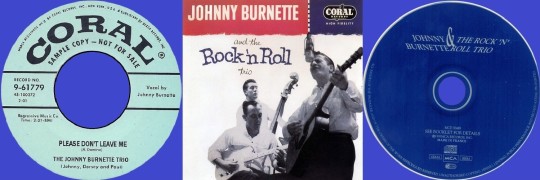
Johnny Burnette & The Rock 'n' Roll Trio - Please Don't Leave Me (1956)
(Alternate Version)
Antoine Dominique Domino Jr. (Fats Domino)
from:
"All by Myself" / "Please Don't Leave Me" (Single)
"Johnny Burnette and The Rock 'n' Roll Trio" (LP)
(1993 CD Reissue)
"Johnny Burnette & The Rock 'n' Roll Trio …Plus"
(2006 Compilation)
Rockabilly | 1st Wave Rock and Roll | Fats Domino Cover
JukeHostUK
(left click = play)
(320kbps)
Personnel:
Johnny Burnette: Vocals / Rhythm Guitar
Paul Burlison: Lead Guitar
Dorsey Burnette: Stand-Up Bass
Grady Martin: Guitar
Bob Moore: Bass
Farris Coursey: Drums
Produced by Henry Jerome
Recorded:
@ The Bradley Film and Recording Studio
in Nashville , Tennessee USA
between 1:45PM and 4:45PM
on Wednesday July 4, 1956
Album Released:
December, 1956
Coral Records
*** *** ***
The band's recordings have exerted a strong influence over subsequent rockabilly artists, although the band did not themselves enjoy broad success at the time.
The Encyclopedia of Recorded Sound indicates an ever more widespread influence, suggesting that "the sheer verve and energy communicated by the Burnette Brothers' recordings influenced the aesthetics of British and American rock stars in the 1960s and 1970's"
- Wikipedia
#Johnny Burnette & The Rock 'n' Roll Trio#Johnny Burnette#Rockabilly#Paul Burlison#Coral Records#1950's#Fats Domino#Dorsey Burnette#1st Wave Rock and Roll#Grady Martin#Bob Moore
6 notes
·
View notes
Video
youtube
Lecture 6: Ricky Nelson (1940-1985), who hailed from a talented musical family, enjoyed a career as one of the biggest Teen Idols of the late 1950s and early 1960s. Nelson got his start as a very young boy starring with his parents, Ozzie and Harriet Nelson, and older brother David, in a hugely popular radio show in the 1940s that went on to become an equally popular TV show in the 1950s, The Adventures of Ozzie and Harriet. In this scene, Ricky sings one of his biggest hits of the 1950s, “It’s Late” (from 1959), a song that skyrocketed into the Top 10 of the Billboard Hot 100. The song was written by pioneering rockabilly singer Dorsey Burnette (1932-1979), and enjoyed a lot of nationwide radio airplay in the spring of 1959.
#Ricky Nelson#Teen Idols#Rock 'n' Roll#1950s#It's Late (1959)#1959#Ozzie Nelson#Harriet Nelson#David Nelson#the adventures of ozzie and harriet#television#Rockabilly#Dorsey Burnette
3 notes
·
View notes
Text
The Beatles and their… let’s call them ‘homages’, shall we?
Baby Let’s Play House - performed by Elvis Presley, written by Arthur Gunter / Run For Your Life
Lonesome Tears in My Eyes - written by Johnny Burnette, Dorsey Burnette, Paul Burlison and Al Mortimer (performed by the Beatles for ‘Pop Go the Beatles’) / The Ballad of John & Yoko
You Can’t Catch Me - written and performed by Chuck Berry / Come Together
#beatles homages#elvis presley#johnny burnette#chuck berry#run for your life#the ballad of john and yoko#come together#the beatles
18 notes
·
View notes
Photo
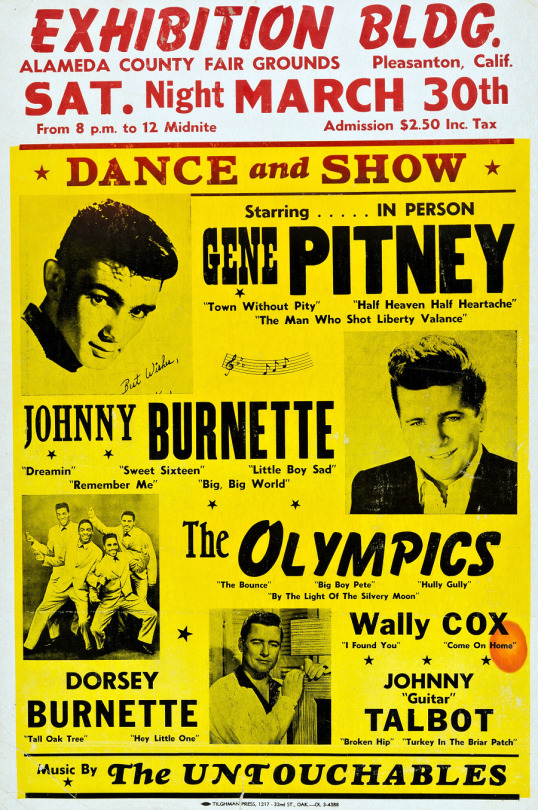
Gene Pitney, Johnny Burnette, Dorsey Burnette, The Olympics, Wally Cox & Johnny Talbot, 1963.
3 notes
·
View notes
Text
A Breath of Fresh Air March 12
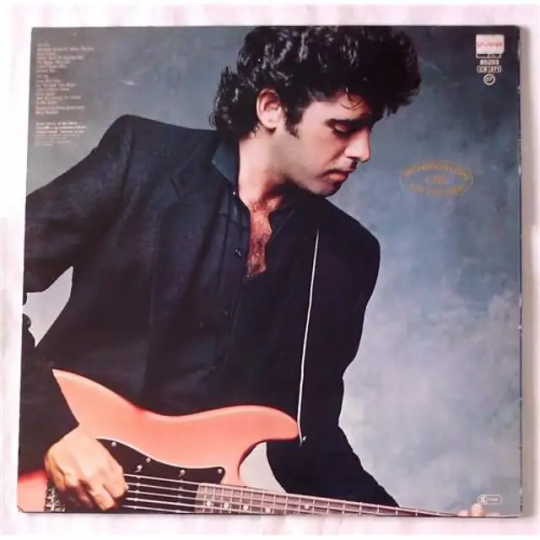
A Breath of Fresh Air With Sandy Kaye
bombshellradio.com
Tuesdays 1pm EST
and Fridays 8pm EST
Archival shows : bombshellradiopodcasts.com
Born in Memphis, singer/songwriter/guitarist, Billy Burnette spent most of his youth in the presence of father Dorsey and uncle Johnny (of the legendary Rock and Roll Trio). The Trio made the Rockabilly name famous by combining the name Billy and his cousin Rocky for the 1953 “Rockabilly Boogie” – thus making the term Rockabilly a household name. The legendary trio influenced a diverse array of Rock icons including: the Elvis, Beatles, Led Zeppelin, Rod Stewart, Aerosmith, and Ricky Nelson. Elvis used to spend many evenings jamming with the band. It’s not surprising then that Billy started making music at the age of 7.
At 15 Billy picked up a guitar and began writing songs. At 18, he was only a week out of high school when he recorded an album with famed Memphis hit-making producer Chips Moman (“Suspicious Minds” and “In the Ghetto” for Elvis). In his early 20’s, Billy wrote songs for artists like Rod Stewart, Ray Charles, Roy Orbison, Tammy Wynette, Jerry Lee Lewis, The Everly Brothers, Conway Twitty, Loretta Lynn, Glen Campbell, and many more.
In 1980, Billy met Mick Fleetwood (of Fleetwood Mac). The two musicians became fast friends and formed the band Mick Fleetwood’s Zoo in 1983. Soon after Billy began his journey as a member of one of the greatest rock bands of all time. Billy joined and toured with Fleetwood Mac between 1987-1995, appearing on many of their albums.
In 2003, Billy co-wrote a tune for Bonnie Raitt and Ray Charles called “Do I Ever Cross Your Mind.” This tune appeared on the album Genius Loves Company, which was the last studio album that Ray Charles recorded and completed. The album garnered 10 Grammy nominations and won Album of the Year.
A collaboration with Shawn Camp and Dennis Morgan became the hit song “River of Love.” George Strait recorded the tune for his 2008 album Troubador, and “River of Love” went on to become Strait’s 44th Number One hit single.
In the last few years, Billy Burnette has contributed his talents as a guitar player and singer on tours with legendary musicians Bob Dylan and John Fogerty. Additionally, he also collaborates regularly with the Mick Fleetwood Band.
Today, Billy continues to write, record and perform. He lives in Nashville and remains as passionate about making music as ever. I hope you enjoy the story of Billy Burnette's musical journey.
Sandy Kaye
[email protected]
Read the full article
0 notes
Text

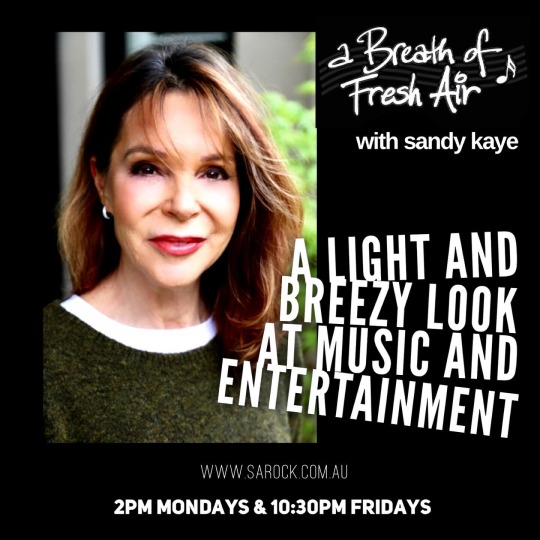


“A BREATH OF FRESH AIR”
with Sandy Kaye
MON 2:00PM & FRI 10:30PM
This week:
Born in Memphis, singer/songwriter/guitarist, Billy Burnette spent most of his youth in the presence of father Dorsey and uncle Johnny (of the legendary Rock and Roll Trio).
The legendary trio influenced a diverse array of Rock icons including: Elvis, The Beatles, Led Zeppelin, Rod Stewart, Aerosmith, and Ricky Nelson.
In his early 20’s, Billy wrote songs for artists like Rod Stewart, Ray Charles, Roy Orbison, Tammy Wynette, Jerry Lee Lewis, The Everly Brothers, Conway Twitty, Loretta Lynn, Glen Campbell, and many more.
Billy joined and toured with Fleetwood Mac between 1987-1995, appearing on many of their albums.
Today, Billy lives in Nashville and continues to write, record and perform. I hope you enjoy the story of Billy Burnette's musical journey.
Join us!
Suggest a guest, feedback & comments: [email protected]
��A BREATH OF FRESH AIR”
with Sandy Kaye
MON 2:00PM & FRI 10:30PM
Listen Live @ https://www.sarock.com.au
SA ROCK RADIO
#internetradio #freeradio #onlineradio #musicinterview
#sarockradio #australianradio #adelaideradio #radioshow #sandykaye #radiostation #sandykayepresents #abreathoffreshair #BillyBurnette #FleetwoodMac
#sarockradio#internet radio#radio#interview#music#sandykayepresents#fleetwood mac#mick fleetwood#Billy Burnette
1 note
·
View note
Text

The Nearness of You
youtube
It's not the pale moon that excites me
That thrills and delights me
Oh no
It's just the nearness of you
It isn't your sweet conversation
That brings this sensation
Oh no
It's just the nearness of you
When you're in my arms
And I feel you so close to me
All my wildest dreams
Came true
I need no soft lights to enchant me
If you would only grant me the right
To hold you ever so tight
And to feel in the night the nearness of you
Songwriter: Dorsey Burnette
❤️❤️❤️❤️❤️❤️❤️❤️❤️❤️❤️❤️
My love,
I long to be forever by your side
You bewitch me with your powerful love
You draw me into your arms with such ease
You are my enchantress
Your embrace is the most beautiful gift I can imagine
You are The woman I want to be with forevermore
I love you deeply ❤️❤️❤️❤️
@dreamiingofher
@adelleandlaura4ever
1 note
·
View note
Text
Amarra o valente

AMARRA O VALENTE SOFTWARE
AMARRA O VALENTE SERIES
AMARRA O VALENTE TV
AMARRA O VALENTE WINDOWS
Studio Master: DSD (Direct-Stream Digital)
AMARRA O VALENTE SOFTWARE
Supported by Apple OS with software player from Amarra, Audirvana, PureMusic).
For users, using Apple/iTunes and a few Network Streaming players.
Studio Master: ALAC (Apple Lossless Audio Coding)
Supported by Apple OS with software player from Amarra, Audirvana, PureMusic, Songbird.
AMARRA O VALENTE WINDOWS
Supported by Windows with software player from Media Monkey, JRiver, JPLAY).Widely compatible with Network Streaming players and D/A Converter's (DAC).Studio Master: FLAC (Free Lossless Audio Codec) HighRes-Studio Master files are lossless at various sample rates from 44.1 kHz up to 384 kHz or 1-bit (2.8224 MHz) for DSD.
AMARRA O VALENTE TV
On January the 14th 2006 Caterina will celebrate her 75th birthday and to the dismay of major European TV-stations and the print media, she has expressed the whish to keep this occasion absolutely private!īut with the publication of the never before released unedited-concert recording used for the famous Heidelberg TV Special including the restored video on DVD of the same special which premiered on CBS in 1969, fans and friends all over the world will once again be spellbound by the magic of this great entertainer! “Girltalk” her latest album of newly recorded material with harpist Catherine Michel was released to international critical acclaim in 2001. In 1986, her 50th anniversary in showbusiness was celebrated with a televised tribute entitled Bravo Caterina, and the Guiness Book of World Records recognized her as Europe’s most successful female recording artist, with over 1350 albums to her credit. Major awards from Italy, Germany (2 crosses of merit), France (officer of artistic education), Brazil, Japan as well as the USA (including a best female vocalist Grammy nomination) document her artistic and civil achievements throughout the years.īut she considers the 18 concerts sharing the stage of the Olympia in Paris with Michel Legrand in 1972 as well as the album VALENTE 86 with the Count Basie Orchestra and relative 1986 European Tour under the direction of, and with arrangements by Thad Jones, to be her artistic highlights. She starred in 12 European movie-musicals she dances (less exuberantly since undergoing two major hip operations) and is a virtuoso on the guitar, having strummed the instrument in an orchestra when only a teen-ager. The Grand Prix du Disque was her award in France for “Bimbombey” and she topped the charts in the US and the UK with the before mentioned “Malaguena” and “The Breeze and I”. In Italy romantic ballads like “Nessuno al mondo” and “Till” brought he gold records. She stormed the charts in Germany with “Ganz Paris träumt von der Liebe” and Tipitipitipso” becoming the queen of German Schlager.
AMARRA O VALENTE SERIES
In “The Entertainers” aired in 1964/65 she shared the bill with Carol Burnett, Dom DeLuise and Bob Newhart and was awarded the FAME Award as best vocalist on American television.įrom the mid fifties to the eighties German, Italian, Swiss and Austrian Television produced more than a dozen series of Valente-Shows and her guest spots over the globe are uncountable.Īmong others, she has performed with Louis Armstrong, Benny Goodman, Ella Fitzgerald, toured extensively in concert with Woody Herman, the Tommy Dorsey Orchestra, Buddy Rich and has recorded with Sy Oliver, Claus Ogerman and Chet Baker just to name a few.īorn in Paris of Italian parents, once married to a German then to an Englishman Caterina Valente easily related to fans wherever she performed, particularly in Europe. Danny Kaye, Perry Como and Bing Crosby often featured her as well, along with other TV hosts. Las Vegas critics raved about the extraordinary talent of the young European vocalist who could sing in 12 languages and she soon found the spotlight on TV, at the Hollywood Palace and Dean Martin was so impressed he invited her on his TV show at least a dozen times. This was followed by the worldwide hit “The Breeze and I”. In 1955 Gordon MacRea presented her on the “Colgate Comedy Hour” as the “Malaguena” Girl. In 1954 Caterina Valente introduced herself to European audiences with her recordings of “Istanbul” and “I love Paris”. “A VOCAL SUPERSTAR IN ANY LANGUAGE!” The Los Angeles Times said it, and who are we to argue? Her conception, phrasing, and timbre are exceptional.” -Leonard Feather: The Encyclopedia of Jazz Is more a jazz singer than many artists so identified in the U.S.

0 notes
Text
Welcome once again, to another fantastic Morning here at the BRN! Thank you for being here with us today!
AND JAGERSHOT FRIDAY!!!!! Woooooohooooo!!!!!
We got the Rock Report for you this morning featuring the Scorpions, some bad legal trouble for Bob Dylan, and a new release from Elfis Costello
This day in Music, With The Beatles, Led Zeppelin and Dorsey Burnette
The Good News break talks about a couple of stray kitties that are ok!. Oh and there’s other stuff too I guess…
And on our 5 Random Facts, Flags with Guns on them, only two, school busses and….barf!
We would like to say a big Thanks to the very nice people at Canna 4 Life for being our sponsor here at the Bone Radio Network! Looking for the best in the Valley? Canna4Life carries the widest selection of products and always has amazing deals! Come in and see for yourself!! The budtenders at Canna4Life love to help you save money so you're sure to get the most bang for your hard earned buck. Open 7 days a week!! Canna4Life. 721 6th Street in Clarkston.
Now…..we rock…cause it’s a Jagershot Friday!
0 notes
Photo

Johnny Burnette and The Rock and Roll Trio, with Paul Burlison and Dorsey Burnette
24 notes
·
View notes
Video
youtube
I’ve been torturing myself with music lately. Something to keep me connected to a person I haven’t spoken to in 11 months. This time of year fucks me up more than usual.
4 notes
·
View notes
Audio

Robert Gordon - Rock Billy Boogie (1979)
Dorsey Burnette / Johnny Burnette /
George Hawkins / Henry Jerome
from:
"Rock Billy Boogie" (LP)
"It's Only Make Believe" / "Rock Billy Boogie" (Single)
Rockabilly | Rockabilly Revival
Johnny Burnette and The Rock 'n Roll Trio Cover
JukeHostUK
(left click = play)
(320kbps)
Personnel:
Robert Gordon: Vocals
Backing Band, The Wildcats:
Chris Spedding: Lead Guitar
Scotty Turner: Rhythm Guitar
Rob Stoner: Bass
Howie Wyeth: Drums
Produced by Richard Gottehrer
( https://en.wikipedia.org/wiki/Richard_Gottehrer )
Recorded:
@ Plaza Sound Studios
(located on the eighth floor of Radio City Music Hall)
in New York City, New York USA
during November of 1978
Single Released:
in February, 1979
Album Released:
1979
CD Reissue:
1992
RCA Records
Of the album, Bruce Eder (AllMusicCom) wrote:
"... there's not a bad song, or even a less-than-first-rate performance anywhere on it."
- Wikipedia
(and he's right)
#Rock Billy Boogie#Robert Gordon#Rockabilly Revival#1970's#RCA Records#Richard Gottehrer#Johnny Burnette#Johnny Burnette and The Rock 'n Roll Trio#Dorsey Burnette#Rockabilly#Chris Spedding
25 notes
·
View notes
Video
youtube
Lecture 6: Ricky Nelson (1940-1985), who hailed from a talented musical family, enjoyed a career as one of the biggest Teen Idols of the late 1950s and early 1960s. Nelson got his start as a very young boy starring with his parents, Ozzie and Harriet Nelson, and older brother David, in a hugely popular radio show in the 1940s that went on to become an equally popular TV show in the 1950s, The Adventures of Ozzie and Harriet. In this scene, Ricky sings one of his biggest hits of the 1950s, “It’s Late” (from 1959), a song that skyrocketed into the Top 10 of the Billboard Hot 100. The song was written by pioneering rockabilly singer Dorsey Burnette (1932-1979), and enjoyed a lot of nationwide radio airplay in the spring of 1959.
#Ricky Nelson#rock 'n' roll#popular music#1950s#It's Late#1959#Dorsey Burnette#Rockabilly#Teen Idols#television#The Adventures of Ozzie and Harriet#Ozzie Nelson#Harriet Nelson#David Nelson
1 note
·
View note
Photo
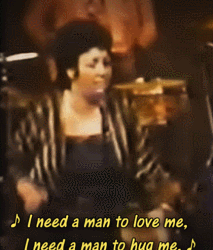


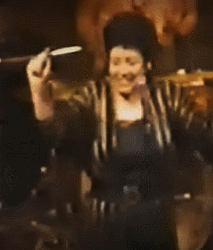
12 Days of Christmas [8/12]: Barbara Pittman.
She was born in an attic on Easter Sunday, April 6, 1938, in Memphis, Tennessee. She had twelve brothers and sisters and grew up in poverty. At three years old she’d sing along to records at her uncle’s pawn shop, one being ‘He May Be Your Man’ by Trixie Smith, causing everyone on Beale Street to gather around her, as she’s stated: “to hear this little half-pint sing those lyrics. I’ve been singing the blues ever since.”
She was from the same neighborhood as Elvis Presley, in the poor white side of Memphis. Their mothers were friends, they had met each other as dietitians at St. Joseph Hospital. They’d get together at each other's houses and have Tupperware parties. “My Uncle Abe and I would go to the movies uptown all the time, and he was an usher at one of the theaters. That was while he was still in high school. I was just a little girl and I was running around behind him and suddenly one day I grew up and he says, ‘Hello dere!'”
At sixteen Barbra got her first singing job at Eagle’s Nest, where Elvis had worked as well. Her stepfather informed the juvenile court authorities about her age and was forced to quit. When Elvis signed to Sun Records, he introduced her to Sam Phillips, she auditioned for him and received another blow to her ego. “He told me to go out and learn how to sing and then come back. Now Marion Keisker [Sam’s receptionist, who discovered Elvis], didn’t want any women in that studio at all, told me to go out and learn how to type or get married because I couldn’t sing. I hadn’t been singing very long. God, I was just a little kid.”
Undaunted, she joined Lash LaRue’s traveling road show, where she worked as a babysitter, and part-time entertainer. He took good care of her until the tour was over, then he dropped her off at a phone booth in Columbus, Ohio. “Fortunately I had a cousin who lived there so I stayed with them for a while before I came back to Memphis.”
Touring with LaRue gave her voice polish, so she when got home in 1956, she was ready to give that audition another try. She made her demo, ‘Playing for Keeps’, written by Stanley Kesler, recorded at the Cotton Club in West Memphis, and Elvis had Sam listen to it. Sam didn’t recognize the girl singing as the same one that auditioned a year earlier.
“Hey, who is this? This sounds real good and I’d like to get her in here and do some things.”
“Well, that’s Barbra Pittman!” Elvis said.
Sam said, “well, I guess she did what I told her to.”
At Sun she was treated like everyone’s kid sister, being young and standoffish. “I was scared of my own shadow”, she laughs. “I was really a shy kid. I was shaking so hard that when I’d get around Elvis he’d call me his vibrator. 'Hey, my back hurts, lean up against me’.” She kept to herself, was picked up by the band at the start of a tour, and head straight home after. Disc jockey Dewey Phillips was protective of her. She dated Jack Clement and was the inspiration for him to write ‘Ballad of a Teenage Queen,’ which was a hit for Johnny Cash. She stayed close friends with Elvis. “We dated and everything, but I just wasn’t his type.”
Jack Clement also wrote her hit, ‘I Need a Man.’ Which her mother wasn’t happy about, but that’s for another story. [link to story] Like most of the recording artists at Sun, her records weren’t being pushed by Sam as much as his golden boys were. Her last single for him was ‘Handsome Man,’ in 1960, under his new affiliated label, Phillips international.
In the early 60′s, she went to Hollywood, but two former neighbors tried to help her recording career, Johnny, and Dorsey Burnette. “They were trying to get me on labels and everything. Then Johnny got killed and everything just stopped. That was the saddest day of my life. [Johnny Burnette died in a boating mishap in 1964.] But they were real good friends, Dorsey was very helpful to me. He got me going when I got out there.”
She rattled around Hollywood for several years, appearing in clubs, working on film soundtracks, and played parts in biker exploitation films. She never hit it big and was nearly forgotten until Elvis’ death, which caused a renewed interest in his Sun contemporaries, especially among European fans. “Suddenly I was discovered,” Barbra crows. “It took me forty years before people started saying 'What about this one female artist on Sun?’ I’ve been to Europe a few times and just had a ball! They treat you like royalty over there.”
Though European tours weren’t enough to completely support her year-round. Times were desperate: she lost her home, went through bankruptcy; recording deals fell through; stateside bookings were thin. But she loved to sing. “It beats any food you could put in your mouth.” She was grateful for the memories of her late friends. She died on October 29, 2005, at her Memphis home, she was 67.
Country Music Changed My Life, The Elvis Factor, Barbra Pittman - Ken Burke. [x]
#Barbara Pittman#Rockabilly#Rock and Roll#Rock#Elvis Presley#1950s#I Need A Man#Music#Story Time#Sam Phillips#Sun Records#1960s#Handsome Man#The Burnette Brothers#Johnny Burnette#Dorsey Burnette#//MyPosts#//Edits#//MyGifs#Gif#GIf//Set#Sun//Mr. Phillips
5 notes
·
View notes
Text
Just some food for thought via Andrew Hickey, who also happens to be the writer/music historian responsible for A History of Rock Music in 500 Songs, one of the only podcasts I can stand to listen to:
The thing that clued me in to Elvis’ neurodivergence, that unlocked this for me, was Sam Phillips talking about signing Elvis. Phillips is often quoted as having wanted “a white man who can sing like a Black man”, but when you listen to the earliest recordings of Elvis, there’s no sensible way anyone could have thought of him that way. What Phillips *actually* said was that “his insecurity was so markedly like that of a Black person.” In particular, in the South at that point, Black people didn’t look white people in the eye. Nor did Elvis.
Both Phillips and Carl Perkins said that Elvis was the most introverted person ever to enter a recording studio, in more or less those exact words.
As a young man, Elvis had very few real friends. He was extremely close to his parents, especially his mother, with whom he almost had a private language and could communicate in a way he couldn’t with anyone else, but had difficulty making friends his own age. He would often hang out with people like Johnny and Dorsey Burnette, who lived nearby. They would bully him, but they’d let him stand on the edge of the group and sing when they were singing.
Later in life, Elvis would surround himself with the “Memphis Mafia”, a group of people to whom he was intensely loyal, even though they were mostly taking advantage of him.
Elvis was known for being constantly in movement, fingers twitching and legs tapping all the time.
He was extremely poor at emotional regulation, and could swing wildly in mood.
He was a very naturally talented actor, who could lose himself in a role (though he was never given the chance to grow).
Before becoming a singer, he worked for a time as an electrician, but he was very bad at it. He kept giving himself electric shocks, and once said it was a miracle none of the houses he worked on had burned down.
He was very into martial arts, which he liked because it allowed him a sense of control over his body.
Some of his stage costumes in the seventies were patterned on his favourite comic-book character, Captain Marvel Jr.
He was a voracious reader and would bring three trunks filled with books on tour with him.
His famous hip-shaking actually started as nerves — he was trembling the first time he was on stage, and it made his baggy trouser legs shake, which the audience took as intentional.
He watched Monty Python and the Holy Grail thirty-five times, and could quote it from memory. He was also a particular fan of Peter Sellers.
He had a highly restricted diet, and had specific issues with textures — food had to be prepared a particular way, with bacon almost burned and eggs hard, and he would eat particular combinations of food many other people found disgusting. People to this day mock him for his taste for peanut-butter, bacon, and banana sandwiches.
He had real problems with sleeping — he was naturally nocturnal, and often had to rely on medical help to get onto a somewhat-diurnal schedule. Even with pharmaceutical help he rarely slept more than three hours at a time.
He had bad skin — the thing people note most about him as a young man was that he had terrible acne on his neck.
He had a near-photographic memory, and would learn and retain a song after hearing it only once. He had an encyclopaedic knowledge of music.
And perhaps most importantly, for much of the last few years of his life he was chronically ill but didn’t present that way. The prescription drug use for which he became notorious after his death was a combination of things to treat his sleep problems, and pain medication. The thing that eventually killed him was not his lifestyle, as reported — he had a variety of genetic, stress-related, inflammatory and autoimmune conditions which made him put on weight, including the hypertension that led to his eventual heart attack. These seem to have been inherited from his mother (who also died in her forties). Again, it’s not a formal diagnostic criterion of autism that one has autoimmune problems, but anecdotally the *vast* majority of autistic people have them (there’s a reason the average life expectancy for an autistic person is fifty-four).
But the pain medication… Elvis told his doctors, for years, that he was in a huge amount of pain. They thought he was faking, because he didn’t “act like” someone in pain — they thought he was after drugs. So sometimes he was prescribed real opiates, but other times he would be given placebos, made to look like the drugs that worked. When those didn’t work, he took more of them, so when he got the real stuff he took more than he should, which made the doctors believe he was just after drugs…
After his death, when those same doctors re-examined X-rays of him, it was obvious he had arthritis, and had really been in unspeakable agony for years. But he’d just not seemed like he was in pain to the doctors. He didn’t act how a person in pain “should” act.
Again, nobody who isn’t neurodivergent will read the above and be convinced. But I think if you’ve any experience of the neurodivergent community, you’re going to read that, and come to the same conclusion as me.
107 notes
·
View notes